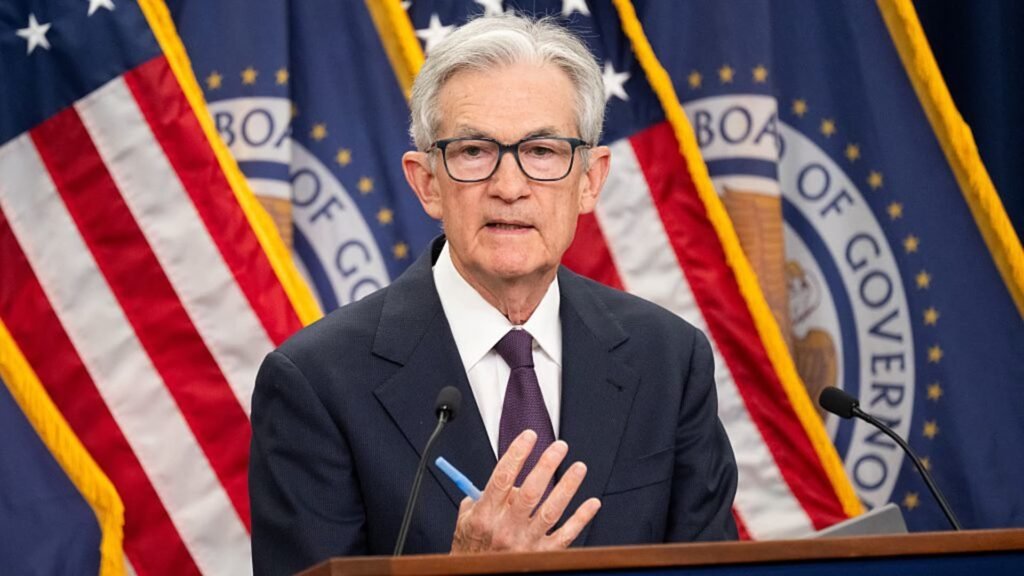
WASHINGTON – On Wednesday, the Federal Reserve decided to maintain current interest rates amidst concerns about increasing inflation and potential economic slowdown, while still hinting at two possible rate cuts later this year.
Given that the markets did not anticipate any changes from the central bank this week, the Federal Open Market Committee has kept its primary interest rate between 4.25%-4.5%, a level it has held since December.
In addition to the rate decision, the committee revealed via its “dot plot” that two rate cuts could still happen by the end of 2025. However, they removed one anticipated cut for both 2026 and 2027, adjusting expected future cuts to four, totaling a full percentage point decrease.
The dot plot illustrated considerable uncertainty from Fed officials regarding future rates. Each dot symbolizes an official’s rate expectations, showing varied viewpoints that suggest a fed funds rate of around 3.4% by 2027.
Seven out of 19 committee members indicated they prefer no cuts this year, an increase from four in March. Still, the policy statement was approved unanimously by the committee.
Economic outlooks from the meeting pointed to continued stagflation risks, with participants estimating a GDP growth of 1.4% in 2025 and inflation reaching 3%.
Downgraded GDP projections
The updated forecasts from March indicate a reduction of 0.3 percentage points for GDP growth, while personal consumption expenditures price index expectations rose by the same amount. The core PCE, which excludes food and energy costs, was adjusted to 3.1%, also an increase of 0.3 percentage points. The unemployment forecast was slightly revised up to 4.5%, marking a 0.1 percentage point increase from March and 0.3 percentage points higher than the current rate.
The FOMC statement largely echoed that of the May gathering. It highlighted that the economy is growing at a “solid pace,” with low unemployment rates and inflation described as “somewhat elevated.”
Furthermore, the committee expressed diminishing concerns about economic fluctuations and ongoing trade policy issues from the White House.
“While uncertainty regarding the economic outlook is lessening, it still remains high. The Committee is vigilant about risks on both sides of its dual objectives,” the committee stated.
During a press conference, Federal Reserve Chairman Jerome Powell indicated a willingness to wait for clearer economic insights.
“At present, we are well positioned to hold off on policy changes until we have more information regarding the economy’s direction,” Powell noted.
U.S. stock markets were mostly stable following the announcement.
Trump advocates for rate reductions
While the Fed’s statement did not provide details on the decrease in uncertainty, President Donald Trump has toned down some of his aggressive trade language, and the White House is currently in a 90-day tariff negotiation period.
However, Trump’s criticism of the Fed remains strong.
Earlier on Wednesday, he criticized Powell and the other officials for not implementing rate cuts. Trump asserted that the federal funds rate should be lowered by at least 2 percentage points and referred to Powell as “stupid” for not advocating for cuts.
Fed officials have been hesitant to make adjustments, worried that tariffs imposed by Trump could lead to inflation in the near future. Current price indicators suggest that the tariffs haven’t significantly influenced prices yet. A potential delay in the effects of tariffs, reduced consumer demand, and increased inventories prior to the April 2 “liberation day” announcement have mitigated their impact so far.
“Many predict a significant rise in inflation due to tariffs because they must be absorbed somehow,” Powell remarked.
The ongoing conflict between Israel and Iran is yet another variable that could impact policy, as rising energy prices could complicate the Fed’s decision-making. The latest statement did not reference any effects from the Middle Eastern tensions.
A softening economy may incentivize future rate cuts this year.
Recent job market data indicates an uptick in layoffs, an increase in long-term unemployment, and reduced consumer spending. Retail sales dropped nearly 1% in May, and indicators show a declining housing market, with new construction reaching a five-year low.
“They’re effectively waiting to see if tariffs push inflation up or if the job market weakens. The area impacted first will likely determine their next steps, though they still appear inclined to cut rates or maintain the current rates rather than raising them,” stated Chris Zaccarelli, chief investment officer at Northlight Asset Management.
Zaccarelli was not surprised by the decision to keep rates steady. However, he noted that the market was taken aback by the assertion that uncertainty had “diminished.”
For Trump, the drive for lower rates is crucial due to the significant expenses the government incurs to finance its $36 trillion debt.
Interest on this debt is projected to reach $1.2 trillion this year, surpassed only by expenditures on Social Security and Medicare. The Fed last cut rates in December, and Treasury yields have remained high throughout the year, adding strain to a budget deficit likely to exceed $2 trillion, equating to over 6% of GDP.
Correction: Meeting participants anticipate that the gross domestic product will grow at a 1.4% rate in 2025. A previous version of this article incorrectly stated the year.


